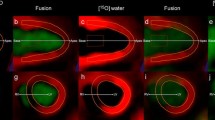Abstract
Purpose
Angiogenesis plays a major role in tissue remodeling and repair after myocardial infarction (MI), and imaging it could provide information on the healing process. During angiogenesis, vascular endothelial growth factor receptors (VEGFRs), platelet-derived growth factor receptors (PDGFRs), and Tie receptors are upregulated, and this study aimed to develop a C-11 positron emission tomography (PET) agent for imaging angiogenesis by targeting these receptors.
Procedures
A VEGFR-2/Tie-2/PDGFRα inhibitor (N-(6-{4-[3-(2-fluoro-5-trifluoromethyl-phenyl)-ureido]-phenoxy}-1H-benzoimidazol-2-yl)-2-(4-methyl-piperazin-1-yl)-acetamide (ATV-1)) was synthesized and labeled with C-11. MicroPET imaging of a rat MI model was compared to proteins expression by immunohistochemistry.
Results
[11C]ATV-1 specifically accumulated in the infracted region of the left ventricular (LV) lateral wall more than in the interventricular septal wall, but not in sham-operated or healthy animals. Moreover, [11C]ATV-1 uptake in the LV significantly correlated with Tie-2, VEGFR-2, and PDGFRα expression.
Conclusion
Imaging angiogenesis in MI rats using [11C]ATV-1 and PET has been demonstrated. These results merit further research and development of more hydrophilic modified [11C]ATV-1 as a PET tracer.






Similar content being viewed by others
References
Conway EM, Collen D, Carmeliet P (2001) Molecular mechanisms of blood vessel growth. Cardiovasc Res 49:507–521
Risau W (1997) Mechanisms of angiogenesis. Nature 386:671–674
Loughna S, Sato TN (2001) Angiopoietin and Tie signaling pathways in vascular development. Matrix Biol 20:319–325
Peters KG, Kontos CD, Lin PC et al (2004) Functional significance of Tie2 signaling in the adult vasculature. Recent Prog Horm Res 59:51–71
Suri C, Jones PF, Patan S et al (1996) Requisite role of angiopoietin-1, a ligand for the TIE2 receptor, during embryonic angiogenesis. Cell 87:1171–1180
Backer MV, Backer JM (2012) Imaging key biomarkers of tumor angiogenesis. Theranostics 2:502–515
Willam C, Koehne P, Jurgensen JS et al (2000) Tie2 receptor expression is stimulated by hypoxia and proinflammatory cytokines in human endothelial cells. Circ Res 87:370–377
Fong GH, Rossant J, Gertsenstein M, Breitman ML (1995) Role of the Flt-1 receptor tyrosine kinase in regulating the assembly of vascular endothelium. Nature 376:66–70
Jeltsch M, Leppanen VM, Saharinen P, Alitalo K (2013) Receptor tyrosine kinase-mediated angiogenesis. Cold Spring Harb Perspect Biol 5. doi:10.1101/cshperspect.a009183
Yancopoulos GD, Davis S, Gale NW et al (2000) Vascular-specific growth factors and blood vessel formation. Nature 407:242–248
Jones N, Iljin K, Dumont DJ, Alitalo K (2001) Tie receptors: new modulators of angiogenic and lymphangiogenic responses. Nat Rev Mol Cell Biol 2:257–267
Alvarez RH, Kantarjian HM, Cortes JE (2006) Biology of platelet-derived growth factor and its involvement in disease. Mayo Clin Proc 81:1241–1257
Tateishi U, Oka T, Inoue T (2012) Radiolabeled RGD peptides as integrin alpha(v)beta3-targeted PET tracers. Curr Med Chem 19:3301–3309
Iagaru A, Gambhir SS (2013) Imaging tumor angiogenesis: the road to clinical utility. AJR Am J Roentgenol 201:W183–W191
Haubner R, Beer AJ, Wang H, Chen X (2010) Positron emission tomography tracers for imaging angiogenesis. Eur J Nucl Med Mol Imaging 37(Suppl 1):S86–S103
Cai W, Niu G, Chen X (2008) Imaging of integrins as biomarkers for tumor angiogenesis. Curr Pharm Des 14:2943–2973
Shyu KG, Chang CC, Wang BW et al (2003) Increased expression of angiopoietin-2 and Tie2 receptor in a rat model of myocardial ischaemia/reperfusion. Clin Sci (Lond) 105:287–294
Shyu KG, Liang YJ, Chang H et al (2004) Enhanced expression of angiopoietin-2 and the Tie2 receptor but not angiopoietin-1 or the Tie1 receptor in a rat model of myocardial infarction. J Biomed Sci 11:163–171
Li J, Brown LF, Hibberd MG, Grossman JD et al (1996) VEGF, flk-1, and flt-1 expression in a rat myocardial infarction model of angiogenesis. Am J Physiol 270:H1803–H1811
Hasegawa M, Nishigaki N, Washio Y et al (2007) Discovery of novel benzimidazoles as potent inhibitors of TIE-2 and VEGFR-2 tyrosine kinase receptors. J Med Chem 50:4453–4470
Leopoldo M, Lacivita E, De Giorgio P et al (2008) Structural modifications of N-(1,2,3,4-tetrahydronaphthalen-1-yl)-4-aryl-1-piperazinehexanamides: influence on lipophilicity and 5-HT7 receptor activity. Part III. J Med Chem 51:5813–5822
Cai L, Chin FT, Pike VW et al (2004) Synthesis and evaluation of two 18F-labeled 6-iodo-2-(4′-N, N-dimethylamino)phenylimidazo[1,2-a]pyridine derivatives as prospective radioligands for beta-amyloid in Alzheimer’s disease. J Med Chem 47:2208–2218
Grass TM, Lurie DI, Coffin JD (2006) Transitional angiogenesis and vascular remodeling during coronary angiogenesis in response to myocardial infarction. Acta Histochem 108:293–302
Armulik A, Abramsson A, Betsholtz C (2005) Endothelial/pericyte interactions. Circ Res 97:512–523
Acknowledgments
The authors wish to thank Sassi Cohen, Daniel Wajnblum, and Nickolay Koroukhov for their invaluable technical support and assistance.
Conflict of Interest
The authors declare that they have no conflicts of interest.
Author information
Authors and Affiliations
Corresponding author
Rights and permissions
About this article
Cite this article
Dissoki, S., Abourbeh, G., Salnikov, O. et al. PET Molecular Imaging of Angiogenesis with a Multiple Tyrosine Kinase Receptor-Targeted Agent in a Rat Model of Myocardial Infarction. Mol Imaging Biol 17, 222–230 (2015). https://doi.org/10.1007/s11307-014-0790-8
Published:
Issue Date:
DOI: https://doi.org/10.1007/s11307-014-0790-8




